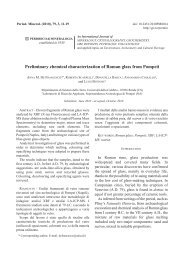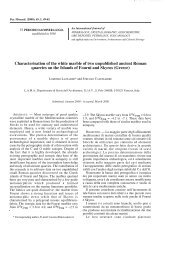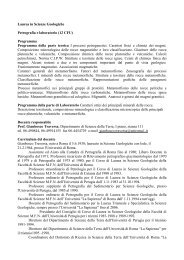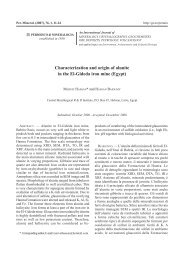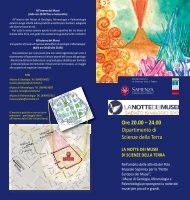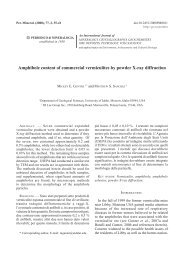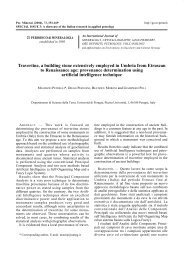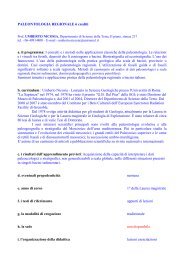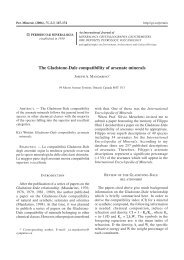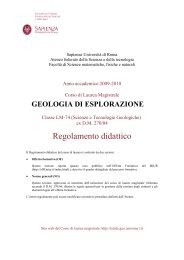Full text - Dipartimento di Scienze della Terra - Sapienza
Full text - Dipartimento di Scienze della Terra - Sapienza
Full text - Dipartimento di Scienze della Terra - Sapienza
- No tags were found...
Create successful ePaper yourself
Turn your PDF publications into a flip-book with our unique Google optimized e-Paper software.
266 M.R. GHIARA, C. PETTI and P. MoRBIDELLI<br />
30<br />
ani<br />
• •<br />
20 •<br />
. ..-<br />
•<br />
•<br />
•<br />
10<br />
. ..<br />
•<br />
• Na/K<br />
0<br />
0 2 4<br />
Fig. 3 - Analcime (ani) contents vs Na/K ratios of all<br />
samples from Table I.<br />
analcime contents evaluated on the basis of X<br />
ray <strong>di</strong>ffraction and they can be roughly used to<br />
estimate the degree of analcimization (fig. 3).<br />
The variation <strong>di</strong>agrams reveal that some<br />
elements (e.g. K20 and Na20) are more or less<br />
62 ----<br />
behaviour is typical of X-type analcime which<br />
is mainly formed by leucite alteration whereas<br />
hydrothermal analcime, <strong>di</strong>splays a strong sharp<br />
endothermic peak between 350 and 370°C.<br />
Microprobe analyses and scanning electron<br />
microscope<br />
The electron microscope coupled with<br />
microprobe analyses on the glassy matrix of F1<br />
sample in<strong>di</strong>cate the following main <strong>text</strong>ures<br />
produced by devetrification processes:<br />
1) spherulitic-like <strong>text</strong>ures consisting of<br />
ra<strong>di</strong>ating aggregates of warm-shaped Fe-Ti<br />
opaques (Table 2; fig. 2);<br />
2) patchy <strong>text</strong>ures following a sharp<br />
boundary between very fine-grained<br />
analcimized and unaltered regions (Table 2;<br />
fig. 2)<br />
The analcime compositions are comparable<br />
to that of literature. The ulvospinel content of<br />
newly formed opaques is 36. 1 wt %.<br />
Microprobe analyses on unaltered parts of glass<br />
are strictly comparable to whole-rock analyses<br />
obtained for fresh sample (e.g. F11, Table 3a).<br />
Major and trace elements variations<br />
50<br />
8<br />
8<br />
4-<br />
0<br />
Na20<br />
•<br />
•<br />
•<br />
f.::· •<br />
. ,.<br />
X .6. ..<br />
•<br />
Scoriaceous fragments of each volcanic<br />
centre <strong>di</strong>splay narrow variations in their MgO<br />
content (e.g. M gO from 2. 11 to 2. 78 wt % in<br />
the Fondo Riccio volcano); this matches the<br />
monogenetic character of scoria cones.<br />
However, wide variations of the Na/K ratios<br />
and consequently of normative nepheline<br />
amounts at same D.I. value occur (Table 1; fig.<br />
3). The Na/K ratios are positively correlated to<br />
4<br />
•<br />
• •<br />
•<br />
M gO<br />
0 +---------------<br />
0 2 4 6<br />
Fig. 4- Si01, Na10 and K10 (wt%) variations of<br />
scoriaceous fr a gme n ts plotted - against MgO (wt%). For<br />
symbols see fig. 1



